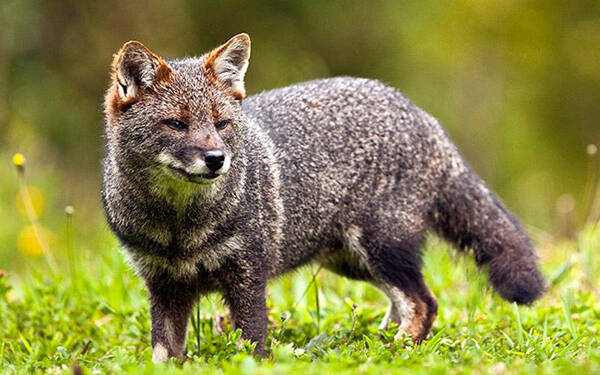Lycalopex fulvipes
IUCN
LCBasic Information
Scientific classification
- name:Lycalopex fulvipes
- Scientific Name:Lycalopex fulvipes,Darwin's Fox,Fox
- Outline:Carnivora
- Family:Schizopoda Canidae Vulpes Pseudocelphus
Vital signs
- length:About 53 cm
- Weight:About 2.8kg
- lifetime:About 7 years
Feature
The fur is dark gray, with red on the legs and face, and the red fur on the ears is particularly bright.
Distribution and Habitat
The Darwin fox is endemic to the South American country of Chile and was once thought to inhabit only the island of Chiloé, located off the southern coast. The island is 200 km long and about 30 km west of Chile. Darwin foxes can be found throughout most of the island, except for the northern part of the island where the rest of the Darwin foxes live. In the 1970s, Darwin foxes living on the mainland were discovered in Nahuelbuta National Park, Chile. The park is located about 600 km north of Chiloé Island.
Prefers to live in secondary forests, typical of temperate rainforest flora. On Chiloé Island, the forest is Valdivian. It contains coniferous species, a few evergreen species, and striped fruit trees. The northern and eastern parts of the island are inhabited by humans, and agriculture has also had some impact on this geographical landscape. On the west coast of the island, Darwin foxes take advantage of fragmented evergreen forest habitats caused by sand dunes. The mainland pop
Appearance
The Darwin fox has a head and body length of 53 cm, a tail length of 22 cm, a foot length of 10 cm, an ear length of 26 cm, and weighs 2.8 kg. It is a very small fox, about the size of a house cat. The ears of this fox are short and round; the legs are relatively short; the slender body and short, bushy tail are its characteristics.
Their fur is a mixture of black and gray, with dark gray fur and red on the legs and face. There is white or cream fur on the abdomen, throat, chest and inside the ears. The red fur on the ear shell is particularly bright. There are purple-red markings on the ears and along the lower part of the legs, and white or light markings under the chin and lower abdomen.
There is no dimorphism between the sexes, but males do have a larger separation between the upper canine teeth than females, resulting in a wider muzzle. Tooth formula: 3 / 3-1 / 1-4 / 4-2 / 3 = 42.
Details
Darwin's Fox (Scientific name: Lycalopex fulvipes) is also known as Darwin's Fox in English. There are no subspecies. In 1834, Charles Darwin discovered and named this animal when he traveled through Chiloe Island.

Darwin's fox is active during both the day and night, with no differences between the sexes, and is solitary outside the breeding season. It is a non-territorial animal, usually sharing its home and core home range with other foxes. Parents share their home range with their offspring. Subadults may be hampered by the availability of open range areas after litter separation, and therefore may remain in the parental home range until they have the opportunity to leave. Darwin's foxes, like other canids, make extensive use of olfactory cues, vocalizations, and gestures to communicate. In general, foxes have an acute sense of smell, hearing, and touch.
Darwin's foxes are omnivores and opportunists. Diet varies with season. It contains a variety of foods, small mammals, birds, crustaceans, reptiles, insects, fruits, grains, nuts, and seeds. Fecal analysis data show that insects are the most abundant food, but small mammals are the largest biomass in the diet. Although Darwin's foxes may gather in areas where carrion is available, they are primarily solitary hunters. In areas where South American gray foxes occur, Darwin's foxes are more active at night, when South American gray foxes are less active.
The natural predator of the mainland population of Darwin's foxes is the cougar. Large birds of prey also prey on these foxes, especially the young ones.
Darwin's foxes are monogamous. Little is known about the mating behavior of this species. Darwin's foxes breed once a year. The breeding season begins in October in the austral spring, and the pups leave the den in December. The litter size is 2-3. Weaning occurs in February. Both parents raise the pups together, and the life span can reach 7 years.
Protected by Chilean law since 1929. Darwin's foxes are listed as endangered in Chile. Since 2012, the Ministry of Environment is developing a recovery, conservation and management plan for the species, but the plan has not yet come into effect.
When Darwin's foxes leave the park in winter to seek milder climates in non-protected private areas, they face threats from humans. People think these foxes are a threat to their poultry and poison them or trap and kill them. Deforestation of the island is also a major problem for the Darwin Fox Reserve. Wild dogs are the biggest threat to the survival of foxes, as are domestic dogs. The remaining Darwin foxes in Nahuelbuta National Park are seriously threatened by various diseases brought by domestic dogs. Park management regulations require that domestic dogs be brought into the national park on a leash, but these regulations are not followed and domestic dogs chase foxes freely in the park.
Although there are a considerable number of foxes on Chiloé Island, logging and poaching in the temperate forests also threaten their survival. The main reason for poaching is to capture small foxes and sell them as pets.
Listed in the 2016 Red List of Endangered Species of the World Conservation Union (IUCN) ver 3.1 - Endangered (EN).
Listed in the Appendix II of the Washington Convention on International Trade in Endangered Species (CITES).
Protect wild animals and eliminate game.
Maintaining ecological balance is everyone's responsibility!








